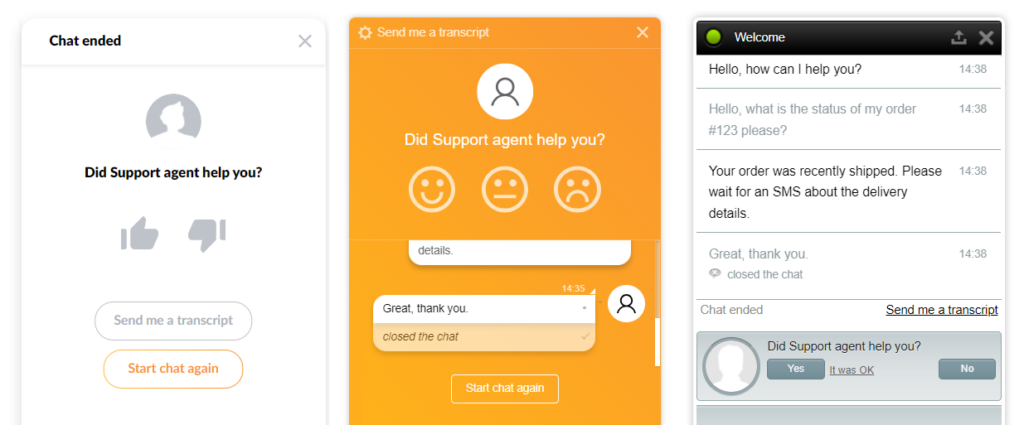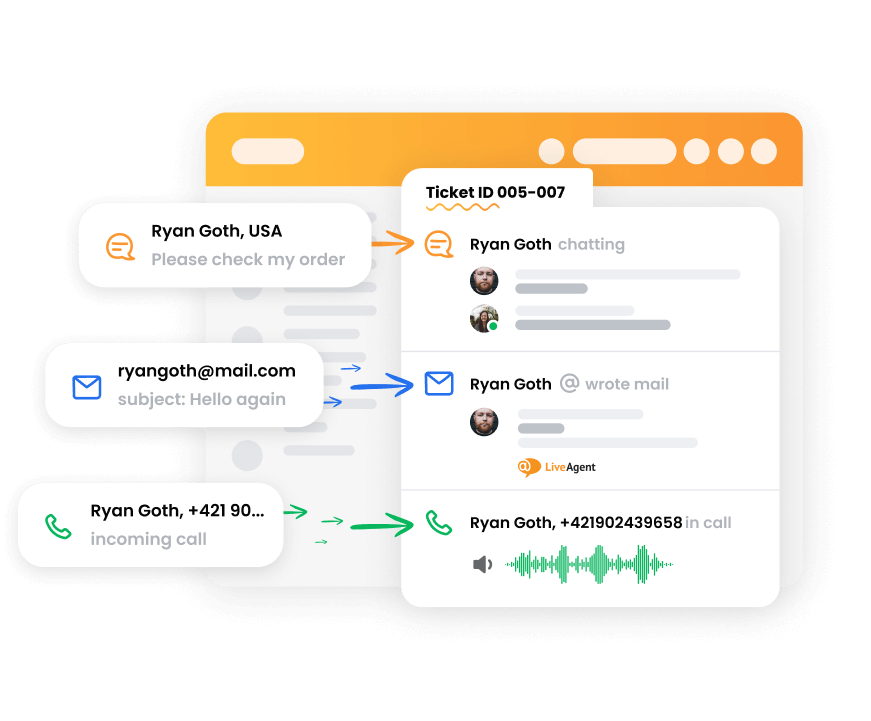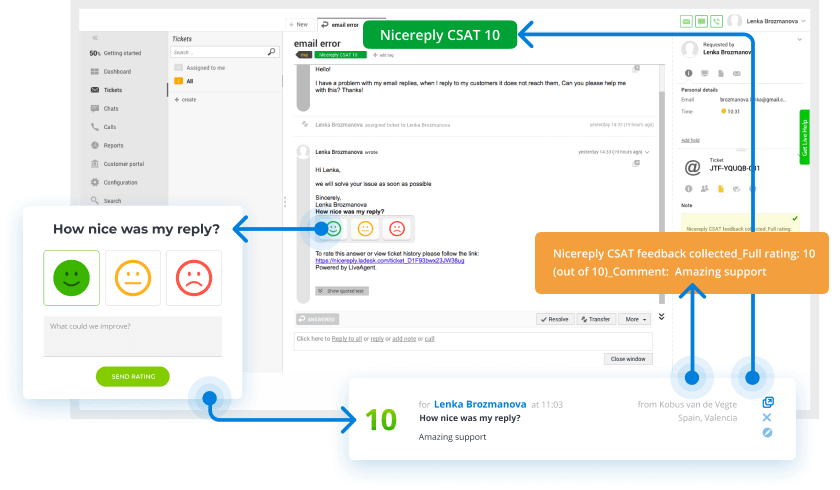What separates one business from the next? The answer lies in customer value, a concept that goes beyond mere pricing strategy to encapsulate the entire experience a customer has with a brand. Understanding this can unlock a powerful competitive edge.
Customer value reflects the perceived benefits that customers receive from a product or service against the costs incurred. It plays a pivotal role in shaping consumer choices and directly impacts a company’s bottom line. When businesses harness the components of customer value effectively, they elevate their performance and foster long-lasting relationships with their customers.
In this article, we will delve into the intricacies of customer value, exploring its significance, measurement techniques, and strategies for enhancement. With solutions such as LiveAgent at your disposal, you can master the art of providing exceptional customer value and drive success in your organization.
What is customer value?
Customer value is the perceived benefit customers gain from a company’s products or services. It is determined by the formula: Customer Value = Total Customer Benefits – Total Customer Costs. This highlights the need to assess both qualitative and quantitative benefits.
There are four types of customer value:
- Functional value: Relates to the product’s performance and usefulness.
- Monetary value: Concerns the price and overall costs associated with the product.
- Social value: Reflects the sense of belonging or peer approval gained from the product.
- Psychological value: Pertains to the emotional gratification gained from the product.
Customer value is subjective and varies based on individual needs and expectations. Creating high customer value is crucial for customer retention and loyalty. Customers who perceive great value in a brand’s offerings are more likely to remain loyal advocates.

In marketing, understanding customer value helps align products with customer expectations, leading to satisfied and loyal customers. For solving the problems related to customer value and experience, LiveAgent stands out as the best option. It offers tools to enhance interactions, ensuring positive experiences and long-term relationships.
The impact of customer value on business performance
Customer value plays a crucial role in driving business performance. It reflects the difference between what customers gain in benefits and what they give up in costs. When companies provide high customer value, they enhance satisfaction, leading to greater loyalty and higher retention rates.
A company that excels in delivering customer value tends to outperform competitors. By offering benefits that outweigh customer costs, businesses can enhance their competitive position. High customer value fosters strong customer loyalty, contributing to revenue growth.
Companies must focus on enhancing multiple elements of value. Positive experiences, product quality, and service qualities are all pivotal. As a result, businesses enjoy long-term customer relationships and a loyal customer base.
For those seeking ways to improve customer value, LiveAgent offers a comprehensive solution. It helps create positive experiences, leading to satisfied customers and long-term success.
Components of customer value
Customer value is calculated by subtracting total customer costs from total customer benefits. It represents the perceived worth of a product or service. Notably, customer value isn’t one-size-fits-all; it has different dimensions. These components help a business build long-term relationships with customers.
There are four types of customer value:
- Functional value: This is about meeting the practical needs of customers. It focuses on the utility and benefits a product or service provides.
- Monetary value: It refers to the cost-related aspects, including affordability and potential for savings.
- Social value: This includes benefits gained from a product’s ability to enable customers to interact with others.
- Psychological value: This captures how the product or service makes customers feel, often tied to brand identity and emotional satisfaction.
Enhancing customer value is vital for customer retention, as it urges customers to continue their engagement, feeling that they are getting their money’s worth. Businesses must integrate technical, economic, service, and social aspects within their offerings to succeed.
Maximize customer value effortlessly
Build long-term relationships by delivering exceptional value. Learn how to increase customer loyalty, retention, and lifetime revenue.
How customer value benefits your audience
Total customer benefits include several factors. Product or service quality, effective solutions they provide, and the brand’s overall reputation are key. Unique experiences associated with a product or service are also critical, as these can boost customer satisfaction and loyalty.
Businesses measure the perception of these benefits using customer satisfaction (CSAT) and net promoter score (NPS) metrics. High scores on these scales indicate strong perceived value. Additionally, partnerships that provide social benefits enhance total customer benefits and make the offering more appealing.
Measuring customer value
Customer value is the perceived benefit a customer gains from a company’s products or services. It’s calculated by subtracting the costs incurred from the total benefits received. Understanding customer value is crucial as it impacts market share and long-term success. Businesses must consider that customer value varies among individuals. That’s why segmenting the customer base into distinct buyer personas is useful. This helps in accurately calculating and enhancing customer value for each group.
To boost customer value, businesses should analyze their customers’ experiences. By identifying interactions that create friction, companies can pinpoint opportunities to add value. The perception of value shifts based on how benefits compare to costs. Therefore, companies must offer benefits that outweigh expenses to increase customer satisfaction and loyalty. When customer value increases, it strengthens competitive position and helps in attracting new and retaining existing customers.
Qualitative assessments
Qualitative assessments involve understanding customer insights through various methods. Conducting in-depth interviews and using feedback forms are effective strategies to gather customer perceptions. Listening to what customers say during interactions lends valuable qualitative data. Monitoring social media can capture unsolicited feedback, providing real-time sentiment analysis.
Customer feedback is crucial in qualitative assessments, enabling businesses to refine their products or services to meet expectations. Regular surveys and customer service metrics further inform these assessments. By analyzing them, businesses identify trends and areas for improvement, fostering a better customer experience.

For example, if customer feedback highlights a need for faster delivery, this insight could lead to a logistical overhaul that enhances customer satisfaction.
Customer value formulas
Determining customer value is often illustrated with a simple formula:
Customer Value = Total Customer Benefits – Total Customer Costs.
This formula measures a product or service’s perceived worth. To assess it effectively, businesses must identify both the benefits and costs involved.
Customer benefits:
- Product quality: Higher quality often implies higher value.
- Brand reputation: A trusted brand enhances perceived value.
- Emotional satisfaction: Positive experiences increase perceived benefits.
Customer costs:
- Monetary costs: Direct financial expenses.
- Time investment: The time customers spend to acquire and use the product.
- Emotional costs: Stress or dissatisfaction associated with the purchase or use.
Measuring these requires quantifying both tangible and intangible factors, offering a clearer comparison of value. Businesses should focus on ensuring that the perceived benefits exceed the costs to build a strong value proposition.
Monetary vs. Non-Monetary Costs
Customer costs are either monetary or non-monetary. Understanding both is crucial for optimizing customer value.
Monetary Costs:
- These involve direct expenses such as purchase price and ongoing fees.
- Financial costs might also include installation or maintenance fees.
Non-Monetary Costs:
- These costs often involve the customer’s time, effort, and emotional investment.
- Learning curves represent time and effort needed to use the product or service.
- Intangible costs may include stress in dealing with a brand or the time required to make purchases.
Measuring these costs is vital for businesses to understand their customers better. Differentiating between tangible financial expenses and intangible emotional implications allows companies to address customer pain points effectively.
For companies aiming to deliver high customer value, leveraging tools like LiveAgent can streamline customer interactions, reduce costs, and enhance experiences. It is a robust solution for nurturing positive customer relationships, leading to satisfaction and long-term success.
Strategies to enhance customer value
Enhancing customer value is pivotal for long-term success in any business. To do this, it’s crucial to know your target market inside out. This involves conducting market research and surveys and using data analytics to understand customer expectations and preferences. By developing a comprehensive customer value strategy, companies can effectively balance customer costs and benefits to maximize perceived worth. Employing customer success managers can further enhance this by addressing potential problems before they escalate to complaints. This tailored approach not only plays a key role in increasing customer retention but also builds a loyal customer base that ensures long-term loyalty and satisfaction.
Delivering exceptional customer experiences
Creating customer value through exceptional customer experiences is mission-critical. Businesses that meet or exceed customer expectations retain satisfied customers who, in turn, contribute to a positive customer base through word-of-mouth and repeat purchases. It’s about offering high-quality products and services, which carve out a competitive edge. Companies that adopt a customer-centric philosophy tend to be more profitable. Understanding how to create and sustain customer value directly impacts brand loyalty and success.

Personalizing interactions
Personalization enhances customer experience and promotes loyalty by making customers feel valued. Address customers by name and provide product recommendations suited to their needs, just like Spotify does with personalized playlists. This can be achieved with AI-driven solutions that offer 24/7 customer support. Personal communication, such as acknowledging customer milestones or sending targeted emails with product suggestions, fosters unique relationships. This approach not only increases customer satisfaction but also strengthens emotional connections between customers and brands.

Implementing loyalty programs
Loyalty programs are a proven way to reward long-term customers and entice new ones. Implementing a tiered program can add customer value by offering exclusive perks and premium support to top-tier participants. More than 90% of companies in the U.S. use loyalty programs, indicating their importance in customer retention strategies. They also foster community, allowing customers to connect and engage in forums. This connection goes beyond incentives, enabling businesses to gather valuable customer data while respecting privacy rules.
Seeking and utilizing customer feedback
Customer feedback is indispensable for business growth. Listening actively to customer feedback allows companies to refine and improve their products or services. Businesses can gather insights through surveys, polls, and reviews, which inform on areas needing improvement. Addressing customer concerns promptly ensures product quality and aligns offerings with customer needs. By resolving issues and valuing feedback, companies foster a sense of respect and care, leading to more positive experiences and long-term relationships. Tools like LiveAgent can streamline and enhance the feedback process, ensuring your business stays agile and responsive to customer needs.

The role of technology in customer value
Technology plays a crucial role in enhancing customer value. It impacts various aspects of the total customer experience, including quality, price, convenience, and support. Improved functionality and durability of products through technological advancements can elevate perceived quality, linking it to customer satisfaction and loyalty.
For instance, technology enables businesses to offer competitive pricing more effectively. By reducing production costs and streamlining operations, companies can align prices better with the enhanced value they provide. This not only attracts new customers but also maintains existing ones, fostering long-term relationships and repeat business.
Furthermore, technology facilitates better post-purchase support. With tools like AI chatbots and digital service platforms, companies can respond promptly to customer queries, enhancing satisfaction and trust.
By improving product quality, optimizing pricing, and providing superior support, technology significantly boosts customer value. Utilizing tools like LiveAgent can ensure businesses meet these demands, ultimately driving long-term success through improved customer relationships and retention.
Maximize customer value effortlessly
Build long-term relationships by delivering exceptional value. Learn how to increase customer loyalty, retention, and lifetime revenue.
Conclusion
In conclusion, understanding and enhancing customer value is crucial for any business aiming for success. Customer value is all about how customers perceive the worth of your product or service, weighing its benefits against the costs. When customers see more benefits than costs, satisfaction and loyalty naturally increase, which in turn boosts profitability and market share.
Businesses that master customer value can tailor their products to meet customer expectations, leading to positive experiences and strong, long-term relationships. Strong customer-centric strategies offer a significant competitive advantage—indeed, such organizations are 60% more profitable.
For companies eager to boost customer satisfaction and retention, exploring tools like LiveAgent can be beneficial. LiveAgent, a top-rated customer service platform, offers a 30-day free trial that lets businesses find new ways to enhance customer interactions. Whether you’re looking to improve customer support or streamline communication, LiveAgent could be the key to building a loyal customer base.
Remember, by prioritizing customer value today, businesses set themselves up for long-term success tomorrow.
Frequently Asked Questions
What is a customer value strategy?
Customer value strategy is an approach that focuses on creating and delivering value to customers, ultimately leading to customer satisfaction and loyalty. It involves understanding your the target audience, creating products/services that meet their needs, and effectively communicating the value proposition to the customers. This may include elements such as personalized customer experiences, high-quality products, and competitive pricing.
How do you create customer value?
Creating customer value involves understanding the needs and preferences of the customers, and then providing products/services that meet or exceed them. You can do so through product or service innovation (developing new and improved products), through excellent customer service and experience (providing seamless interactions between your business and your customers), and by building a strong brand and reputation (trust and credibility with customers).
What factors influence customer value?
Customer value can be influenced by various factors, including product quality, pricing, customer service, and brand reputation. For example, a company that offers high-quality products with excellent customer service and a strong brand reputation may be perceived as providing more value to its customers compared to a competitor that lacks in these areas.
What are the benefits of customer value?
Customer value has both the tangible and intangible benefits. Delivering high customer value can lead to increased customer loyalty and retention, higher levels of customer satisfaction, positive word-of-mouth referrals, increased competitiveness in the market, and increased profitability. However, the perception of value is subjective and can vary from one customer to another. Therefore, companies need to carefully understand their target audience and strive to deliver and communicate the value they provide.
What is customer value?
Customer value is defined as the perception of what a product or service is worth to a customer against the possible alternatives.
What is a customer value proposition?
A customer value proposition is a statement that outlines why potential customers would benefit from buying a product or using a service. It is the keystone of an effective product marketing strategy. Basically, it’s the total sum of benefits that should convince consumers why a product or service will be of more value to them than similar offerings on the market.
Why is customer value important?
If done right, a customer value proposition can give a business a huge advantage over the competitors. However, very few businesses have effective value propositions. A recent study revealed that 83% of marketers pay little attention to the customer value propositions in their strategies, campaigns, and ads. But, only 17% really understand and embrace what a customer lifetime value proposition is.
Understanding customer retention: Definition, importance, and strategies
Master customer retention with 13 proven strategies, key metrics, and real examples. Boost loyalty, profits, and brand reputation today!

 Български
Български  Čeština
Čeština  Dansk
Dansk  Deutsch
Deutsch  Eesti
Eesti  Español
Español  Français
Français  Ελληνικα
Ελληνικα  Hrvatski
Hrvatski  Italiano
Italiano  Latviešu
Latviešu  Lietuviškai
Lietuviškai  Magyar
Magyar  Nederlands
Nederlands  Norsk bokmål
Norsk bokmål  Polski
Polski  Română
Română  Русский
Русский  Slovenčina
Slovenčina  Slovenščina
Slovenščina  简体中文
简体中文  Tagalog
Tagalog  Tiếng Việt
Tiếng Việt  العربية
العربية  Português
Português 


